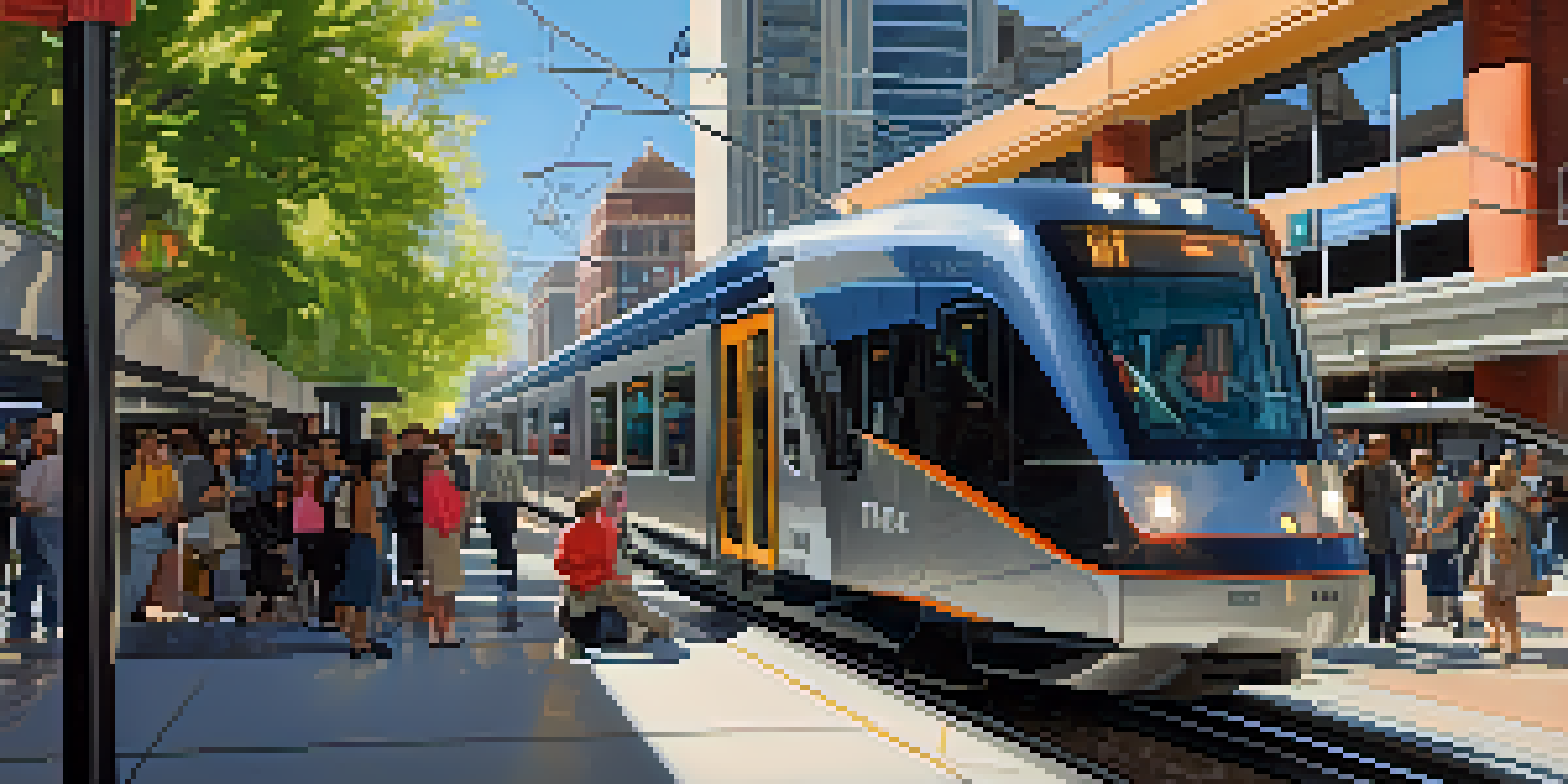Exploring Public Transportation Options in Salt Lake City

An Overview of Salt Lake City's Public Transportation System
Salt Lake City boasts a comprehensive public transportation system that caters to residents and visitors alike. With a blend of buses, light rail, and commuter services, navigating the city is both convenient and efficient. The Utah Transit Authority (UTA) manages the bulk of these services, ensuring that various routes connect key areas, including downtown, the airport, and nearby neighborhoods.
Good public transportation is the backbone of a vibrant community.
One of the highlights of the system is the TRAX light rail service, which provides a quick and comfortable way to travel across the city. With multiple lines and frequent service, TRAX is a popular choice for both commuters and tourists. Additionally, UTA operates a bus network that complements the light rail, offering extensive coverage throughout Salt Lake County.
For those seeking a budget-friendly option, using public transportation can save money on gas and parking fees. Plus, with the city’s commitment to sustainability, choosing public transit helps reduce your carbon footprint while exploring Salt Lake City.
Getting Started: How to Use TRAX Light Rail
TRAX is an excellent starting point for anyone looking to explore Salt Lake City. To begin your journey, you can easily find a TRAX station, often located near major attractions, shopping areas, and residential neighborhoods. Once at the station, purchasing a ticket is straightforward, whether you opt for a single ride or a day pass for unlimited travel.

The light rail system is divided into three lines—Red, Blue, and Green—each covering different parts of the city. The trains run frequently, so you'll rarely have to wait long for the next one. Plus, each station is equipped with maps and schedules, making it easy to plan your trip.
Comprehensive Public Transit Options
Salt Lake City offers a well-rounded public transportation system that includes buses, light rail, and commuter services for efficient travel.
As you ride TRAX, take a moment to enjoy the views of the surrounding mountains and cityscape. It’s not just a mode of transport; it’s a chance to see Salt Lake City from a unique perspective, all while getting to your destination efficiently.
Exploring the Bus Routes in Salt Lake City
While TRAX is a popular choice, Salt Lake City's bus system offers extensive coverage for areas not serviced by light rail. UTA's bus routes traverse the city and beyond, connecting neighborhoods to key destinations like schools, shopping centers, and parks. With hundreds of routes available, you're likely to find a bus stop conveniently located near you.
Sustainable transportation is not just a choice; it’s a necessity for our planet’s future.
Buses typically run on a regular schedule, with frequency varying by route and time of day. Real-time tracking apps and UTA's website can help you stay informed about bus arrivals, making it easier to plan your journey. The buses are also equipped for accessibility, ensuring that everyone can enjoy Salt Lake City's public transport.
For a local flavor, hop on a bus and chat with fellow passengers. You'll often find that public transport is a melting pot of experiences, showcasing the diversity of the city and its residents.
Connecting to Nearby Attractions with Commuter Rail
For those looking to venture beyond Salt Lake City, the FrontRunner commuter rail offers an excellent option. This service connects Salt Lake City to various towns along the Wasatch Front, making it perfect for day trips or weekend getaways. With stops in cities like Ogden and Provo, you can explore even more of what Utah has to offer.
FrontRunner trains are comfortable, with spacious seating and onboard amenities. The journey provides breathtaking views of the surrounding mountains and valleys, making the trip itself a memorable part of your adventure. Plus, frequent service means you can easily plan your outings without stress.
Sustainable Travel Choices
Opting for public transit in Salt Lake City helps reduce carbon emissions and traffic congestion, promoting a healthier environment.
Whether you're heading to a nearby ski resort in the winter or exploring charming downtowns in the summer, the commuter rail opens up a world of possibilities. It’s a convenient way to experience the natural beauty and cultural offerings of Utah.
The Eco-Friendly Benefits of Public Transit
Using public transportation in Salt Lake City is not just about convenience; it’s also a step towards sustainability. By opting for buses or light rail instead of driving, you contribute to reduced traffic congestion and lower carbon emissions. This is especially important in a city surrounded by stunning natural landscapes that we all want to preserve.
Public transit systems like UTA are committed to eco-friendly practices, including energy-efficient vehicles and green initiatives. The more people who choose public transportation, the less pressure there is on the environment. It’s a simple yet impactful way to make a difference.
Moreover, as cities grow, maintaining a healthy environment becomes crucial. Embracing public transit helps create a cleaner, greener Salt Lake City for future generations, allowing everyone to enjoy the beauty of Utah’s landscapes.
Navigating the Fare System: Tips and Tricks
Understanding the fare system is essential for a smooth experience on Salt Lake City's public transportation. UTA offers various fare options, from single rides to monthly passes, catering to different needs. For occasional travelers, purchasing a day pass can be the most budget-friendly choice, allowing unlimited rides within a 24-hour period.
It's also worth noting that children, seniors, and people with disabilities can often benefit from reduced fares, making public transit accessible to everyone. Be sure to check UTA's website for the latest fare information and any available discounts.
User-Friendly Fare System
UTA provides various fare options, including discounts for children, seniors, and people with disabilities, making public transit accessible to all.
When using TRAX or the bus, remember to keep your ticket handy, as fare enforcement officers may check for valid tickets. This simple tip can save you from unexpected fines and ensure a worry-free journey.
Safety Tips for Riding Public Transportation
Safety is a top priority when using public transportation, and Salt Lake City is no exception. UTA maintains a strong presence on both buses and light rail, with trained personnel ensuring a safe environment for all passengers. You can feel confident that help is readily available should you need it.
As with any public space, it’s wise to stay aware of your surroundings while riding. Keep your belongings close and avoid displaying valuables openly. If you’re traveling at night, consider riding with a friend or using well-lit stations to enhance your safety.

Remember, public transportation is meant to be enjoyable and stress-free. By following these simple safety tips, you can focus on the journey and the sights Salt Lake City has to offer, rather than worrying about your surroundings.
The Future of Public Transportation in Salt Lake City
Looking ahead, Salt Lake City is continuously working to improve its public transportation system. Plans for new routes, increased service frequency, and modernized vehicles are all part of an ongoing effort to make public transit more attractive to residents and visitors. This commitment to improvement reflects the city’s dedication to sustainable urban development.
Additionally, advancements in technology are playing a significant role in shaping the future of public transit. Mobile apps for real-time tracking and fare payment are becoming commonplace, making the process even more user-friendly. As these innovations roll out, navigating Salt Lake City’s public transit will become easier than ever.
Ultimately, a robust public transportation system is essential for a vibrant city. By investing in transit, Salt Lake City is not only enhancing mobility but also promoting economic growth and environmental sustainability.